Podcast
Questions and Answers
What is the primary function of the plasma membrane?
What is the primary function of the plasma membrane?
- To regulate the movement of substances in and out of the cell (correct)
- To produce proteins
- To store genetic information
- To generate cellular energy
Which characteristic allows the plasma membrane to act as a semi-permeable regulator?
Which characteristic allows the plasma membrane to act as a semi-permeable regulator?
- Its flexibility and structure (correct)
- Its high permeability
- Its impermeable nature
- Its rigidity
What type of molecules in the plasma membrane act as gatekeepers?
What type of molecules in the plasma membrane act as gatekeepers?
- Lipids
- Carbohydrates
- Integral proteins (correct)
- Nucleic acids
What role do lipids play in the plasma membrane?
What role do lipids play in the plasma membrane?
How do plasma membranes help in cellular identification?
How do plasma membranes help in cellular identification?
Which of the following best describes the structure of the plasma membrane?
Which of the following best describes the structure of the plasma membrane?
Which function is NOT associated with the plasma membrane?
Which function is NOT associated with the plasma membrane?
How do transmembrane proteins contribute to membrane function?
How do transmembrane proteins contribute to membrane function?
Which of the following is a barrier to polar substances?
Which of the following is a barrier to polar substances?
Which component of the plasma membrane aids in cellular communication?
Which component of the plasma membrane aids in cellular communication?
Flashcards are hidden until you start studying
Study Notes
Plasma Membrane Proteins
- Ion channels: allow specific ions to move through water-filled pores; most plasma membranes include specific channels for several common ions
- Carrier proteins: carry specific substances across membrane by changing shape; examples include amino acid carriers
- Enzymes: catalyze reactions inside or outside cell; examples include lactase that splits lactose in the small intestine
- Linker proteins: anchor filaments inside and outside the plasma membrane, providing structural stability and shape for the cell
- Receptor proteins: recognize specific ligands and alter cell function; examples include antidiuretic hormone receptors in the kidneys
- Cell-identity markers (glycoproteins): distinguish cells from others; examples include major histocompatibility (MHC) proteins
Mechanisms of Membrane Transport
Passive Transport
- Diffusion: movement of solutes or water from high to low concentration
- Facilitated diffusion: requires specific channel or carrier molecule, no energy used
Active Transport
- Requires energy (ATP)
Simple Diffusion
- Movement of substance across membrane from high to low concentration
Facilitated Diffusion
- Requires membrane proteins; examples include channel-mediated and carrier-mediated facilitated diffusion
Carrier-Mediated Facilitated Diffusion
- Carrier proteins bind to molecules and change shape to move them across the membrane
Secondary Active Transport Mechanisms
- Use energy stored in Na+ or H+ concentration gradients to drive transport of other solutes against their concentration gradients
- Examples include antiporters and symporters
Antiporters
- Carry two substances across the membrane in opposite directions
Symporters
- Carry two substances across the membrane in the same direction
Ion Channels
- Allow passive movement of specific ions down their electrochemical gradient
- Regulated or "gated" holes through the membrane
- Examples include K+, Na+, Cl-, Ca2+ ion channels
- Mechanisms of gating include voltage, ligands, temperature, pH, and mechanical stress
Primary Active Transport Mechanisms (Pumps)
- Sodium-Potassium pump (Na-K-ATPase)
- Requires energy from ATP hydrolysis
- Crucial for maintaining cell volume and ionic gradients responsible for setting resting membrane potential and generating action potentials
Transporters (Carriers)
- Allow passive movement of solutes across membrane down their concentration gradient
- Examples include GLUT1 glucose transporter
- Exhibit saturation kinetics
Tonicity
- Measure of a solution's ability to change cell volume by altering water content
- Osmosis occurs between fluid compartments separated by semi-permeable membranes
Isotonic Solution
- Solution with same concentration of solutes as the cell
Hypotonic Solution
- Solution with lower concentration of solutes than the cell
Hypertonic Solution
- Solution with higher concentration of solutes than the cell
Passive Membrane Transport - Diffusion
- Random spread of particles from high to low concentration
- Depends on amount of substance, concentration gradient, temperature, surface area, and diffusion distance
Osmosis
- Passive net movement of water through a selectively permeable membrane from high to low water concentration
- Occurs when a membrane is permeable to water but not solutes
- Water can pass through plasma membrane by simple diffusion or through aquaporins (integral membrane proteins)
Function of the Plasma Membrane
- Flexible yet sturdy semi-permeable regulator
- Covers and protects the cell
- Controls what goes in and comes out
- Links to other cells
- Displays "flags" to tell other cells "who" it is
Studying That Suits You
Use AI to generate personalized quizzes and flashcards to suit your learning preferences.



